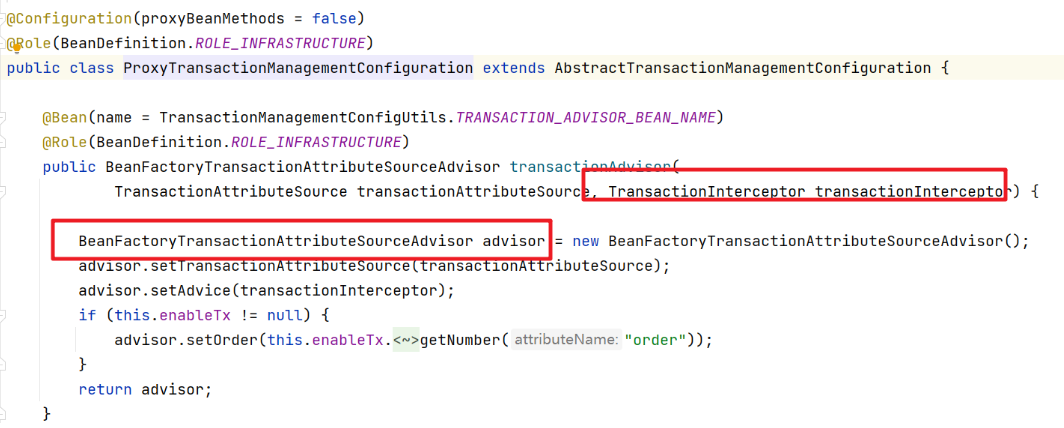一、事务的本质?
什么是事务?
数据库事务(Database Transaction) ,是指作为单个逻辑工作单元执行的一系列操作,要么完全地执行,要么完全地不执行。
事务处理可以确保除非事务性单元内的所有操作都成功完成,否则不会永久更新面向数据的资源。通过将一组相关操作组合为一个要么全部成功要么全部失败的单元,可以简化错误恢复并使应用程序更加可靠。
一个逻辑工作单元要成为事务,必须满足所谓的 ACID(原子性、一致性、隔离性和持久性)属性。事务是数据库运行中的逻辑工作单位,由DBMS中的事务管理子系统负责事务的处理。
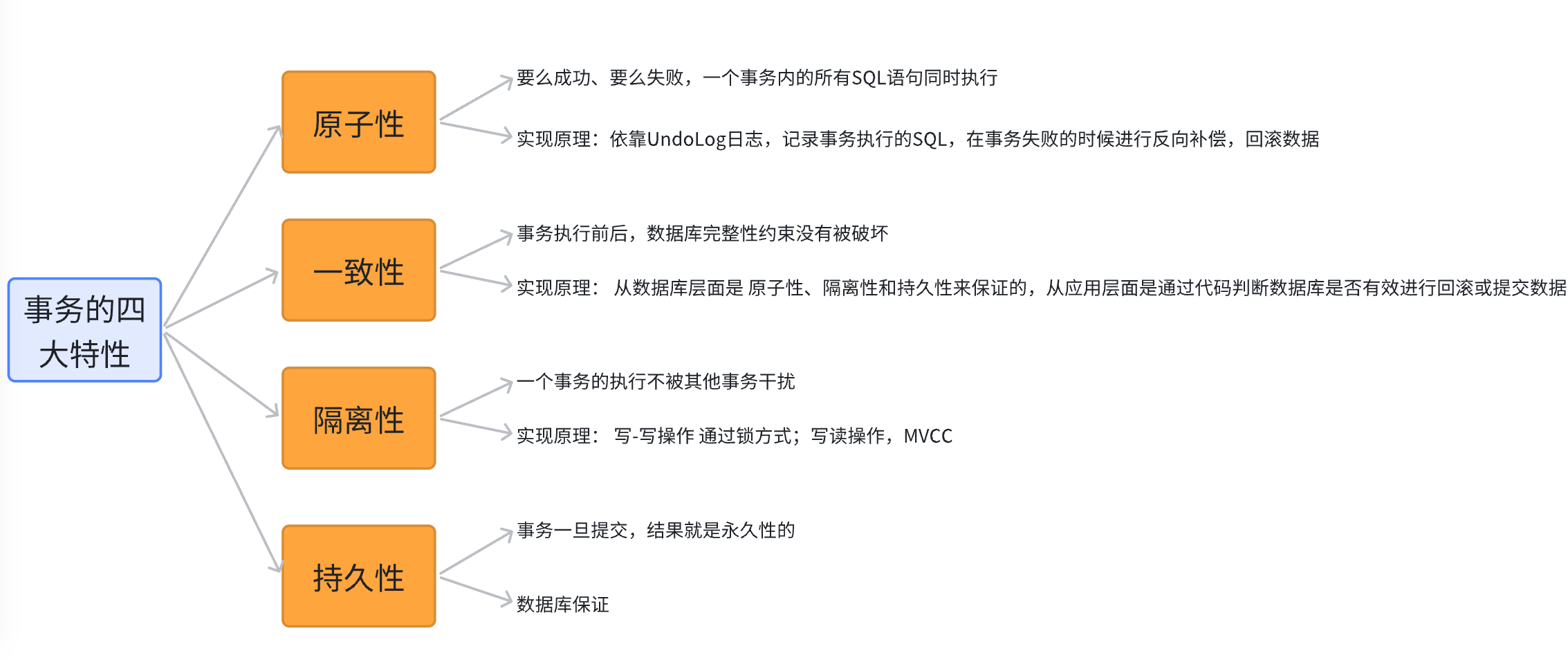
JDBC中是怎么处理事务的?
JDBC(Java Database Connectivity)提供了对数据库事务的支持,主要通过Connection对象来控制事务。
核心事务控制方法
JDBC通过Connection接口提供了以下关键事务控制方法:setAutoCommit(boolean autoCommit)- 设置自动提交模式
commit()- 提交事务rollback()- 回滚事务
public static void main(String[] args) {
Connection conn = null;
Statement stmt = null;
try {
// 注册 JDBC 驱动
// Class.forName("com.mysql.cj.jdbc.Driver");
// 打开连接
conn = DriverManager.getConnection("jdbc:mysql://localhost:3306/test?characterEncoding=utf-8&serverTimezone=UTC", "root", "123456");
// 执行查询
stmt = conn.createStatement();
conn.setAutoCommit(false); // 关闭自动提交
// 添加用户信息
String sql = "INSERT INTO T_USER(id,user_name)values(1,'管理员')";
stmt.executeUpdate(sql);
// 添加日志问题
sql = "INSET INTO t_log(id,log)values(1,'添加了用户:管理员')";
stmt.executeUpdate(sql);
conn.commit(); // 上面两个操作都没有问题就提交
} catch (Exception e) {
e.printStackTrace();
// 出现问题就回滚
try {
conn.rollback();
} catch (SQLException throwables) {
throwables.printStackTrace();
}
} finally {
try {
if (stmt != null) stmt.close();
} catch (SQLException se2) {
}
try {
if (conn != null) conn.close();
} catch (SQLException se) {
se.printStackTrace();
}
}
}关键操作:关闭自动提交,都成功就commit,有一个失败就rollback
在Spring中的事务管理?
我们在Service中是可能调用多个Dao的方法来操作数据库中的数据的,我们要做的就是要保证UserService中的 addUser()方法中的相关操作满足事务的要求。在Spring中支持两种事务的使用方式
一种是基于XML的文件配置方式,一种是基于注解的方式。
在Spring的底层:PlatformTransactionManager
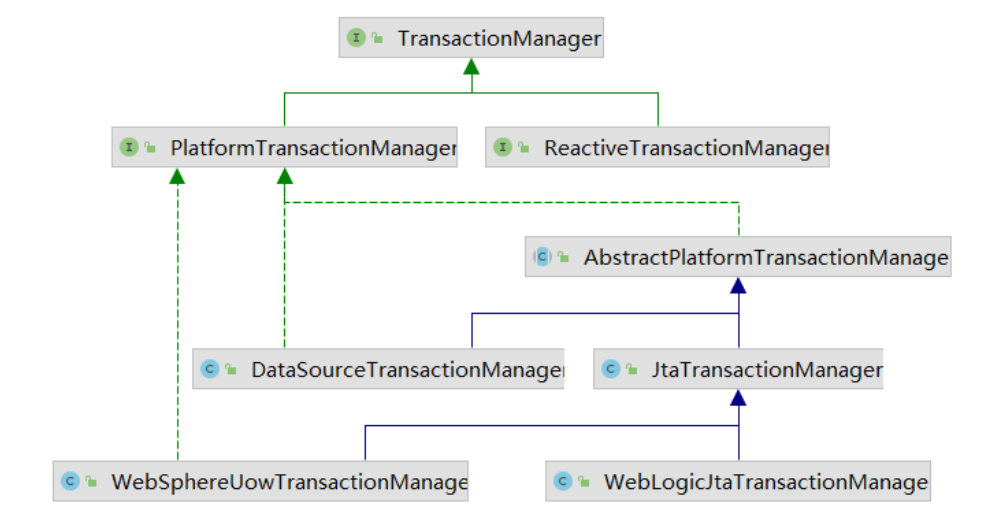
TransactionManager顶级接口,但是内容为空的
public interface TransactionManager {
}PlatformTransactionManager:平台事务管理器
ReactiveTransactionManager:响应式编程的事务管理器关注的重点是PlatformTransactionManager:
public interface PlatformTransactionManager extends TransactionManager {
/**
获取事务
*/
TransactionStatus getTransaction(@Nullable TransactionDefinition definition)
throws TransactionException;
/**
提交数据
*/
void commit(TransactionStatus status) throws TransactionException;
/**
回滚数据
*/
void rollback(TransactionStatus status) throws TransactionException;
}PlatformTransactionManager也是个接口,在他下面的实现有两个比较重要实现
JtaTransactionManager:支持分布式事务【本身服务中的多数据源】
DataSourceTransactionManager:数据源事务管理器。在但数据源中的事务管理,这个是我们分析的重点。
在DataSourceTransactionManager中提供了与事务相关的操作方法。
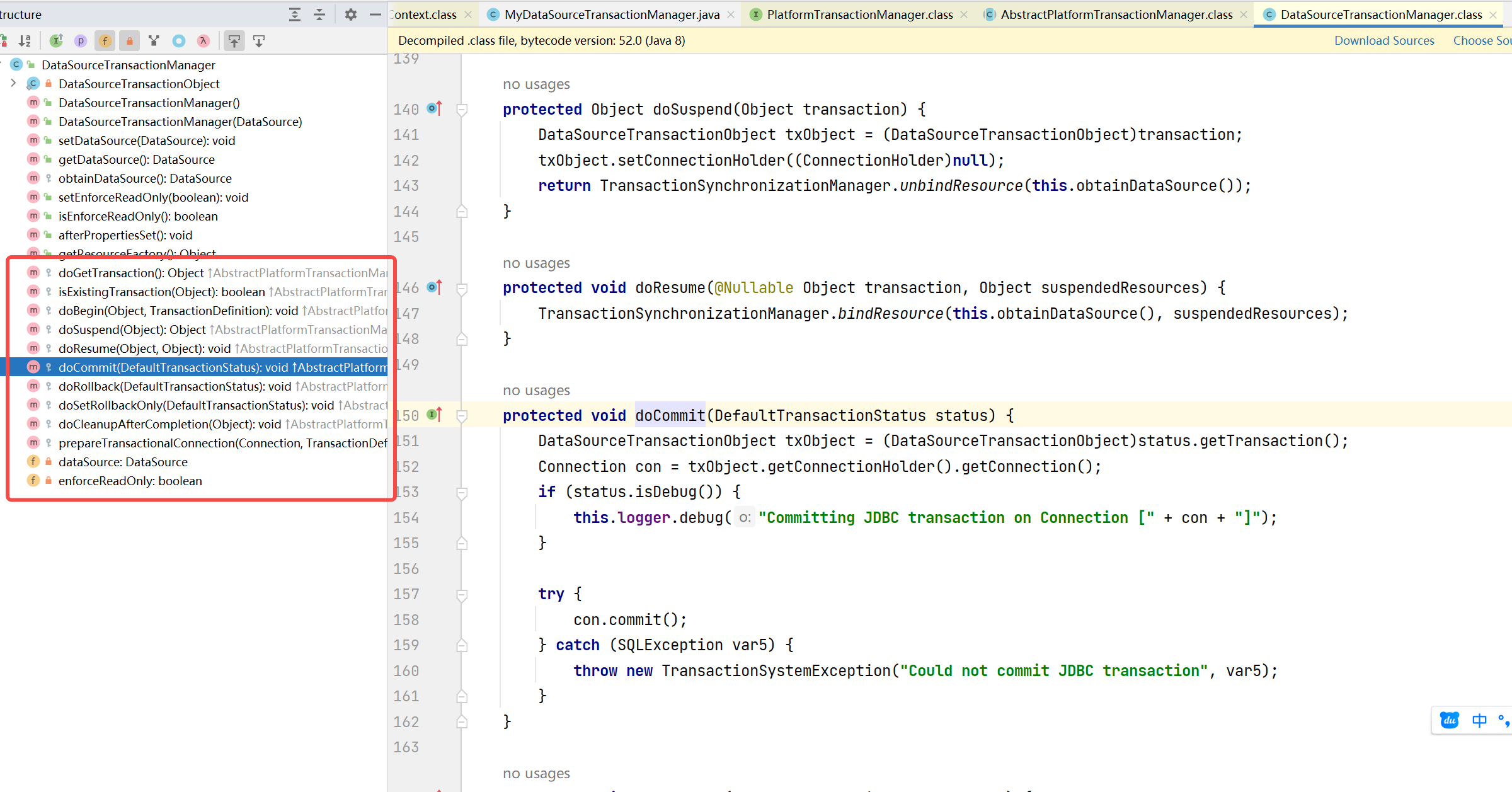
事务的定义
在上面的 PlatformTransactoinManager中看到了 TransactionDefinition 这个对象,通过字面含义是 事务定义。

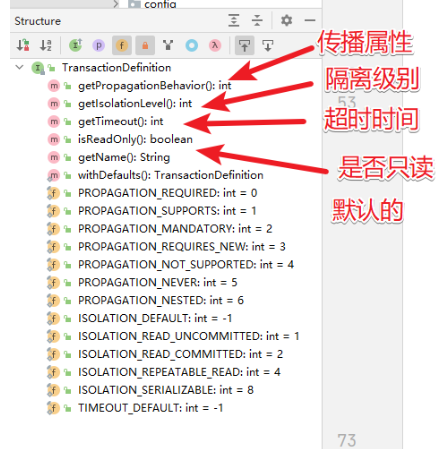
TransactionDefinition中定义了事务的 传播属性和 隔离级别
DefaultTransactionDefinition:是事务定义的默认实现
DefaultTransactionAttribute:扩展了TransactionAttribute中的属性的实现
@Transactional:该组件就会被解析加载为对应的 TransactionDefinition对象。
开启事务
然后在 PlatformTransactionManager中获取事务的时候返回的是 TransactionStatus对象。
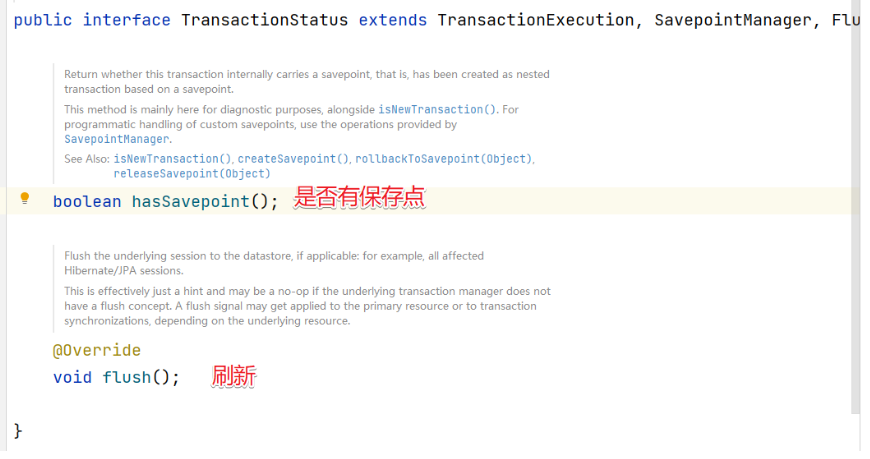
核心方法
getTransaction
/**
* This implementation handles propagation behavior. Delegates to
* {@code doGetTransaction}, {@code isExistingTransaction}
* and {@code doBegin}.
* @see #doGetTransaction
* @see #isExistingTransaction
* @see #doBegin
*/
@Override
public final TransactionStatus getTransaction(@Nullable TransactionDefinition definition)
throws TransactionException {
// Use defaults if no transaction definition given.
// 如果没有事务定义信息则使用默认的事务管理器定义信息
TransactionDefinition def = (definition != null ? definition : TransactionDefinition.withDefaults());
// 获取事务
Object transaction = doGetTransaction();
boolean debugEnabled = logger.isDebugEnabled();
// 判断当前线程是否存在事务,判断依据为当前线程记录的连接不为空且连接中的transactionActive属性不为空
if (isExistingTransaction(transaction)) {
// Existing transaction found -> check propagation behavior to find out how to behave.
// 当前线程已经存在事务
return handleExistingTransaction(def, transaction, debugEnabled);
}
// Check definition settings for new transaction.
// 事务超时设置验证
if (def.getTimeout() < TransactionDefinition.TIMEOUT_DEFAULT) {
throw new InvalidTimeoutException("Invalid transaction timeout", def.getTimeout());
}
// No existing transaction found -> check propagation behavior to find out how to proceed.
// 如果当前线程不存在事务,但是PropagationBehavior却被声明为PROPAGATION_MANDATORY抛出异常
if (def.getPropagationBehavior() == TransactionDefinition.PROPAGATION_MANDATORY) {
throw new IllegalTransactionStateException(
"No existing transaction found for transaction marked with propagation 'mandatory'");
}
// PROPAGATION_REQUIRED,PROPAGATION_REQUIRES_NEW,PROPAGATION_NESTED都需要新建事务
else if (def.getPropagationBehavior() == TransactionDefinition.PROPAGATION_REQUIRED ||
def.getPropagationBehavior() == TransactionDefinition.PROPAGATION_REQUIRES_NEW ||
def.getPropagationBehavior() == TransactionDefinition.PROPAGATION_NESTED) {
//没有当前事务的话,REQUIRED,REQUIRES_NEW,NESTED挂起的是空事务,然后创建一个新事务
SuspendedResourcesHolder suspendedResources = suspend(null);
if (debugEnabled) {
logger.debug("Creating new transaction with name [" + def.getName() + "]: " + def);
}
try {
return startTransaction(def, transaction, debugEnabled, suspendedResources);
}
catch (RuntimeException | Error ex) {
// 恢复挂起的事务
resume(null, suspendedResources);
throw ex;
}
}
else {
// Create "empty" transaction: no actual transaction, but potentially synchronization.
// 创建一个空的事务
if (def.getIsolationLevel() != TransactionDefinition.ISOLATION_DEFAULT && logger.isWarnEnabled()) {
logger.warn("Custom isolation level specified but no actual transaction initiated; " +
"isolation level will effectively be ignored: " + def);
}
boolean newSynchronization = (getTransactionSynchronization() == SYNCHRONIZATION_ALWAYS);
return prepareTransactionStatus(def, null, true, newSynchronization, debugEnabled, null);
}
}doGetTransaction()
/**
* 创建一个DataSourceTransactionObject当作事务,设置是否允许保存点,然后获取连接持有器ConnectionHolder
* 里面会存放JDBC的连接,设置给DataSourceTransactionObject,当然第一次是空的
*
* @return
*/
@Override
protected Object doGetTransaction() {
// 创建一个数据源事务对象
DataSourceTransactionObject txObject = new DataSourceTransactionObject();
// 是否允许当前事务设置保持点
txObject.setSavepointAllowed(isNestedTransactionAllowed());
/**
* TransactionSynchronizationManager 事务同步管理器对象(该类中都是局部线程变量)
* 用来保存当前事务的信息,我们第一次从这里去线程变量中获取 事务连接持有器对象 通过数据源为key去获取
* 由于第一次进来开始事务 我们的事务同步管理器中没有被存放.所以此时获取出来的conHolder为null
*/
ConnectionHolder conHolder =
(ConnectionHolder) TransactionSynchronizationManager.getResource(obtainDataSource());
// 非新创建连接则写false
txObject.setConnectionHolder(conHolder, false);
// 返回事务对象
return txObject;
}/**
* Create a TransactionStatus for an existing transaction.
*/
private TransactionStatus handleExistingTransaction(
TransactionDefinition definition, Object transaction, boolean debugEnabled)
throws TransactionException {
/**
* 判断当前的事务行为是不是PROPAGATION_NEVER的
* 表示为不支持事务,但是当前又存在一个事务,所以抛出异常
*/
if (definition.getPropagationBehavior() == TransactionDefinition.PROPAGATION_NEVER) {
throw new IllegalTransactionStateException(
"Existing transaction found for transaction marked with propagation 'never'");
}
/**
* 判断当前的事务属性不支持事务,PROPAGATION_NOT_SUPPORTED,所以需要先挂起已经存在的事务
*/
if (definition.getPropagationBehavior() == TransactionDefinition.PROPAGATION_NOT_SUPPORTED) {
if (debugEnabled) {
logger.debug("Suspending current transaction");
}
// 挂起当前事务
Object suspendedResources = suspend(transaction);
boolean newSynchronization = (getTransactionSynchronization() == SYNCHRONIZATION_ALWAYS);
// 创建一个新的非事务状态(保存了上一个存在事务状态的属性)
return prepareTransactionStatus(
definition, null, false, newSynchronization, debugEnabled, suspendedResources);
}
/**
* 当前的事务属性状态是PROPAGATION_REQUIRES_NEW表示需要新开启一个事务状态
*/
if (definition.getPropagationBehavior() == TransactionDefinition.PROPAGATION_REQUIRES_NEW) {
if (debugEnabled) {
logger.debug("Suspending current transaction, creating new transaction with name [" +
definition.getName() + "]");
}
// 挂起当前事务并返回挂起的资源持有器
SuspendedResourcesHolder suspendedResources = suspend(transaction);
try {
// 创建一个新的非事务状态(保存了上一个存在事务状态的属性)
return startTransaction(definition, transaction, debugEnabled, suspendedResources);
}
catch (RuntimeException | Error beginEx) {
resumeAfterBeginException(transaction, suspendedResources, beginEx);
throw beginEx;
}
}
// 嵌套事务
if (definition.getPropagationBehavior() == TransactionDefinition.PROPAGATION_NESTED) {
// 不允许就报异常
if (!isNestedTransactionAllowed()) {
throw new NestedTransactionNotSupportedException(
"Transaction manager does not allow nested transactions by default - " +
"specify 'nestedTransactionAllowed' property with value 'true'");
}
if (debugEnabled) {
logger.debug("Creating nested transaction with name [" + definition.getName() + "]");
}
// 嵌套事务的处理
if (useSavepointForNestedTransaction()) {
// Create savepoint within existing Spring-managed transaction,
// through the SavepointManager API implemented by TransactionStatus.
// Usually uses JDBC 3.0 savepoints. Never activates Spring synchronization.
// 如果没有可以使用保存点的方式控制事务回滚,那么在嵌入式事务的建立初始简历保存点
DefaultTransactionStatus status =
prepareTransactionStatus(definition, transaction, false, false, debugEnabled, null);
// 为事务设置一个回退点
status.createAndHoldSavepoint();
return status;
}
else {
// Nested transaction through nested begin and commit/rollback calls.
// Usually only for JTA: Spring synchronization might get activated here
// in case of a pre-existing JTA transaction.
// 有些情况是不能使用保存点操作
return startTransaction(definition, transaction, debugEnabled, null);
}
}
// Assumably PROPAGATION_SUPPORTS or PROPAGATION_REQUIRED.
if (debugEnabled) {
logger.debug("Participating in existing transaction");
}
if (isValidateExistingTransaction()) {
if (definition.getIsolationLevel() != TransactionDefinition.ISOLATION_DEFAULT) {
Integer currentIsolationLevel = TransactionSynchronizationManager.getCurrentTransactionIsolationLevel();
if (currentIsolationLevel == null || currentIsolationLevel != definition.getIsolationLevel()) {
Constants isoConstants = DefaultTransactionDefinition.constants;
throw new IllegalTransactionStateException("Participating transaction with definition [" +
definition + "] specifies isolation level which is incompatible with existing transaction: " +
(currentIsolationLevel != null ?
isoConstants.toCode(currentIsolationLevel, DefaultTransactionDefinition.PREFIX_ISOLATION) :
"(unknown)"));
}
}
if (!definition.isReadOnly()) {
if (TransactionSynchronizationManager.isCurrentTransactionReadOnly()) {
throw new IllegalTransactionStateException("Participating transaction with definition [" +
definition + "] is not marked as read-only but existing transaction is");
}
}
}
boolean newSynchronization = (getTransactionSynchronization() != SYNCHRONIZATION_NEVER);
return prepareTransactionStatus(definition, transaction, false, newSynchronization, debugEnabled, null);
}startTransaction()
/**
* Start a new transaction.
*/
private TransactionStatus startTransaction(TransactionDefinition definition, Object transaction,
boolean debugEnabled, @Nullable SuspendedResourcesHolder suspendedResources) {
// 是否需要新同步
boolean newSynchronization = (getTransactionSynchronization() != SYNCHRONIZATION_NEVER);
// 创建新的事务
DefaultTransactionStatus status = newTransactionStatus(
definition, transaction, true, newSynchronization, debugEnabled, suspendedResources);
// 开启事务和连接
doBegin(transaction, definition);
// 新同步事务的设置,针对于当前线程的设置
prepareSynchronization(status, definition);
return status;
}doBegin方法开启和连接事务
@Override
protected void doBegin(Object transaction, TransactionDefinition definition) {
// 强制转化事务对象
DataSourceTransactionObject txObject = (DataSourceTransactionObject) transaction;
Connection con = null;
try {
// 判断事务对象没有数据库连接持有器
if (!txObject.hasConnectionHolder() ||
txObject.getConnectionHolder().isSynchronizedWithTransaction()) {
// 通过数据源获取一个数据库连接对象
Connection newCon = obtainDataSource().getConnection();
if (logger.isDebugEnabled()) {
logger.debug("Acquired Connection [" + newCon + "] for JDBC transaction");
}
// 把我们的数据库连接包装成一个ConnectionHolder对象 然后设置到我们的txObject对象中去
txObject.setConnectionHolder(new ConnectionHolder(newCon), true);
}
// 标记当前的连接是一个同步事务
txObject.getConnectionHolder().setSynchronizedWithTransaction(true);
con = txObject.getConnectionHolder().getConnection();
// 为当前的事务设置隔离级别
Integer previousIsolationLevel = DataSourceUtils.prepareConnectionForTransaction(con, definition);
// 设置先前隔离级别
txObject.setPreviousIsolationLevel(previousIsolationLevel);
// 设置是否只读
txObject.setReadOnly(definition.isReadOnly());
// Switch to manual commit if necessary. This is very expensive in some JDBC drivers,
// so we don't want to do it unnecessarily (for example if we've explicitly
// configured the connection pool to set it already).
// 关闭自动提交
if (con.getAutoCommit()) {
//设置需要恢复自动提交
txObject.setMustRestoreAutoCommit(true);
if (logger.isDebugEnabled()) {
logger.debug("Switching JDBC Connection [" + con + "] to manual commit");
}
// 关闭自动提交
con.setAutoCommit(false);
}
// 判断事务是否需要设置为只读事务
prepareTransactionalConnection(con, definition);
// 标记激活事务
txObject.getConnectionHolder().setTransactionActive(true);
// 设置事务超时时间
int timeout = determineTimeout(definition);
if (timeout != TransactionDefinition.TIMEOUT_DEFAULT) {
txObject.getConnectionHolder().setTimeoutInSeconds(timeout);
}
// Bind the connection holder to the thread.
// 绑定我们的数据源和连接到我们的同步管理器上,把数据源作为key,数据库连接作为value 设置到线程变量中
if (txObject.isNewConnectionHolder()) {
// 将当前获取到的连接绑定到当前线程
TransactionSynchronizationManager.bindResource(obtainDataSource(), txObject.getConnectionHolder());
}
}
catch (Throwable ex) {
if (txObject.isNewConnectionHolder()) {
// 释放数据库连接
DataSourceUtils.releaseConnection(con, obtainDataSource());
txObject.setConnectionHolder(null, false);
}
throw new CannotCreateTransactionException("Could not open JDBC Connection for transaction", ex);
}
}doBegin方法中核心的关闭了自动提交
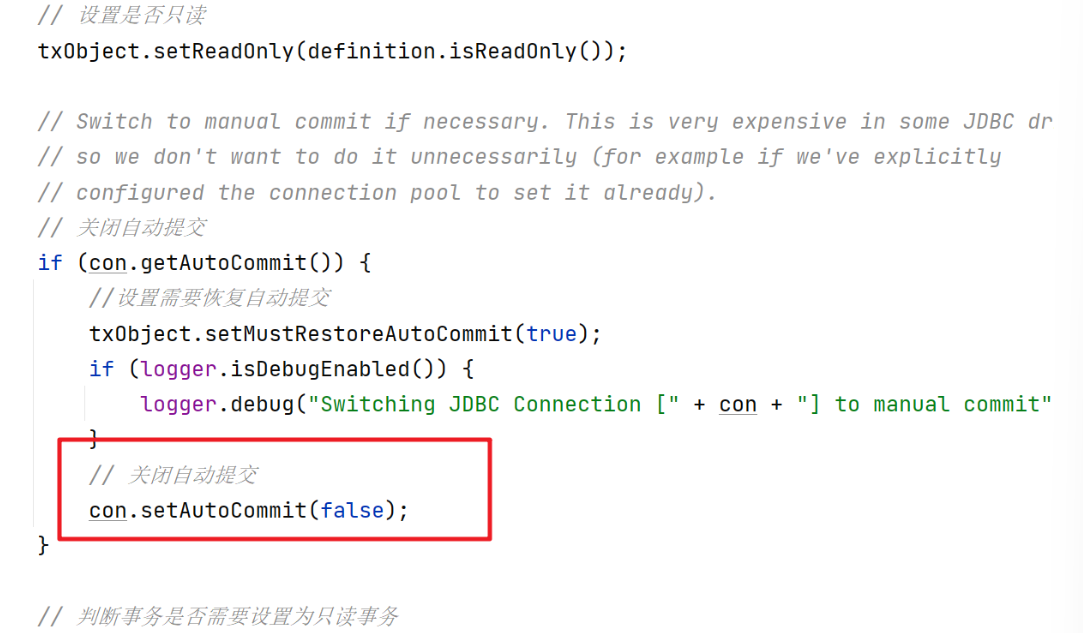
同时把连接绑定到本地线程中bindResource方法
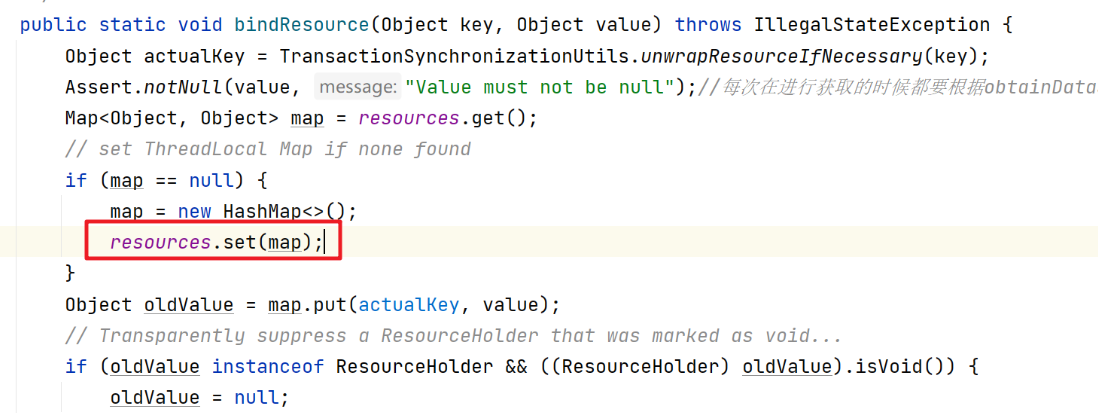
Spring事务源码串联
编程式事务、AOP事务
@Autowired
private UserDao userDao;
@Autowired
private PlatformTransactionManager txManager;
@Autowired
private LogService logService;
@Transactional
public void insertUser(User u) {
// 1、创建事务定义
DefaultTransactionDefinition definition = new DefaultTransactionDefinition();
// 2、根据定义开启事务
TransactionStatus status = txManager.getTransaction(definition);
try {
this.userDao.insert(u);
Log log = new Log(System.currentTimeMillis() + "", System.currentTimeMillis() + "-" + u.getUserName());
// this.doAddUser(u);
this.logService.insertLog(log);
// 3、提交事务
txManager.commit(status);
} catch (Exception e) {
// 4、异常了,回滚事务
txManager.rollback(status);
throw e;
}
}在Service中通过事务处理的代码实现了事务管理,同时结合AOP的内容,可以把事务的代码抽取出来,然后我们来看看Spring中这块是如何处理的。
 通过Debug的方式看到处理的关键流程
通过Debug的方式看到处理的关键流程 TransactionInterceptor 就是事务处理的 advice
@Override
@Nullable
public Object invoke(MethodInvocation invocation) throws Throwable {
// Work out the target class: may be {@code null}.
// The TransactionAttributeSource should be passed the target class
// as well as the method, which may be from an interface.
Class<?> targetClass = (invocation.getThis() != null ? AopUtils.getTargetClass(invocation.getThis()) : null);
// Adapt to TransactionAspectSupport's invokeWithinTransaction...
return invokeWithinTransaction(invocation.getMethod(), targetClass, invocation::proceed);
}进入到invokeWithinTransaction方法中
@Nullable
protected Object invokeWithinTransaction(Method method, @Nullable Class<?> targetClass,
final InvocationCallback invocation) throws Throwable {
// If the transaction attribute is null, the method is non-transactional.
// 获取我们的事务属性源对象
TransactionAttributeSource tas = getTransactionAttributeSource();
// 通过事务属性源对象获取到当前方法的事务属性信息
final TransactionAttribute txAttr = (tas != null ? tas.getTransactionAttribute(method, targetClass) : null);
// 获取我们配置的事务管理器对象
final TransactionManager tm = determineTransactionManager(txAttr);
if (this.reactiveAdapterRegistry != null && tm instanceof ReactiveTransactionManager) {
ReactiveTransactionSupport txSupport = this.transactionSupportCache.computeIfAbsent(method, key -> {
if (KotlinDetector.isKotlinType(method.getDeclaringClass()) && KotlinDelegate.isSuspend(method)) {
throw new TransactionUsageException(
"Unsupported annotated transaction on suspending function detected: " + method +
". Use TransactionalOperator.transactional extensions instead.");
}
ReactiveAdapter adapter = this.reactiveAdapterRegistry.getAdapter(method.getReturnType());
if (adapter == null) {
throw new IllegalStateException("Cannot apply reactive transaction to non-reactive return type: " +
method.getReturnType());
}
return new ReactiveTransactionSupport(adapter);
});
return txSupport.invokeWithinTransaction(
method, targetClass, invocation, txAttr, (ReactiveTransactionManager) tm);
}
PlatformTransactionManager ptm = asPlatformTransactionManager(tm);
// 获取连接点的唯一标识 类名+方法名
final String joinpointIdentification = methodIdentification(method, targetClass, txAttr);
// 声明式事务处理
if (txAttr == null || !(ptm instanceof CallbackPreferringPlatformTransactionManager)) {
// Standard transaction demarcation with getTransaction and commit/rollback calls.
// 创建TransactionInfo
TransactionInfo txInfo = createTransactionIfNecessary(ptm, txAttr, joinpointIdentification);
Object retVal;
try {
// This is an around advice: Invoke the next interceptor in the chain.
// This will normally result in a target object being invoked.
// 执行被增强方法,调用具体的处理逻辑
retVal = invocation.proceedWithInvocation();
}
catch (Throwable ex) {
// target invocation exception
// 异常回滚
completeTransactionAfterThrowing(txInfo, ex);
throw ex;
}
finally {
//清除事务信息,恢复线程私有的老的事务信息
cleanupTransactionInfo(txInfo);
}
if (retVal != null && vavrPresent && VavrDelegate.isVavrTry(retVal)) {
// Set rollback-only in case of Vavr failure matching our rollback rules...
TransactionStatus status = txInfo.getTransactionStatus();
if (status != null && txAttr != null) {
retVal = VavrDelegate.evaluateTryFailure(retVal, txAttr, status);
}
}
//成功后提交,会进行资源储量,连接释放,恢复挂起事务等操作
commitTransactionAfterReturning(txInfo);
return retVal;
}
else {
// 编程式事务处理
Object result;
final ThrowableHolder throwableHolder = new ThrowableHolder();
// It's a CallbackPreferringPlatformTransactionManager: pass a TransactionCallback in.
try {
result = ((CallbackPreferringPlatformTransactionManager) ptm).execute(txAttr, status -> {
TransactionInfo txInfo = prepareTransactionInfo(ptm, txAttr, joinpointIdentification, status);
try {
Object retVal = invocation.proceedWithInvocation();
if (retVal != null && vavrPresent && VavrDelegate.isVavrTry(retVal)) {
// Set rollback-only in case of Vavr failure matching our rollback rules...
retVal = VavrDelegate.evaluateTryFailure(retVal, txAttr, status);
}
return retVal;
}
catch (Throwable ex) {
if (txAttr.rollbackOn(ex)) {
// A RuntimeException: will lead to a rollback.
if (ex instanceof RuntimeException) {
throw (RuntimeException) ex;
}
else {
throw new ThrowableHolderException(ex);
}
}
else {
// A normal return value: will lead to a commit.
throwableHolder.throwable = ex;
return null;
}
}
finally {
cleanupTransactionInfo(txInfo);
}
});
}
catch (ThrowableHolderException ex) {
throw ex.getCause();
}
catch (TransactionSystemException ex2) {
if (throwableHolder.throwable != null) {
logger.error("Application exception overridden by commit exception", throwableHolder.throwable);
ex2.initApplicationException(throwableHolder.throwable);
}
throw ex2;
}
catch (Throwable ex2) {
if (throwableHolder.throwable != null) {
logger.error("Application exception overridden by commit exception", throwableHolder.throwable);
}
throw ex2;
}
// Check result state: It might indicate a Throwable to rethrow.
if (throwableHolder.throwable != null) {
throw throwableHolder.throwable;
}
return result;
}
}然后进入到createTransactionIfNecessary方法中
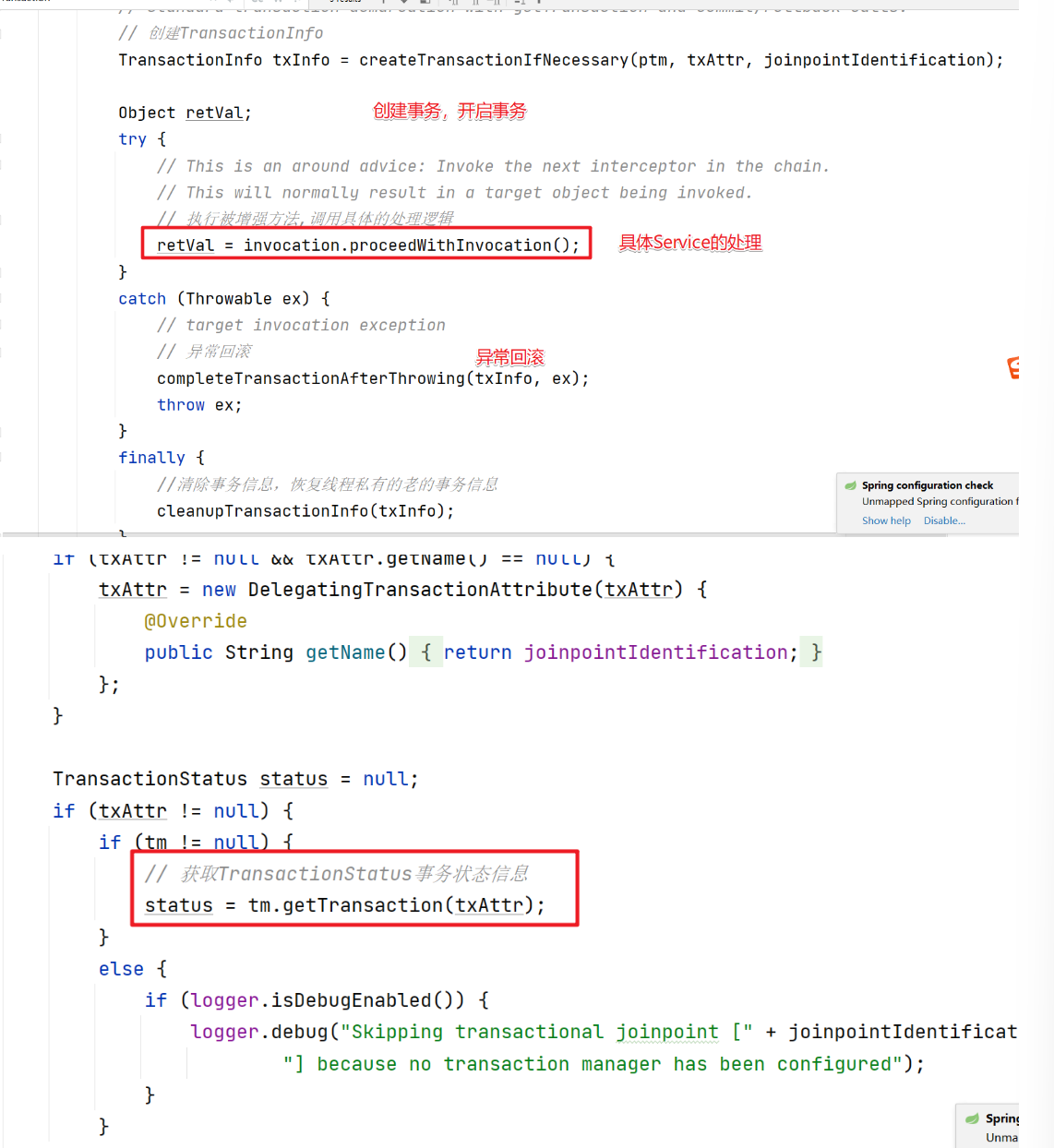
进入 getTransaction
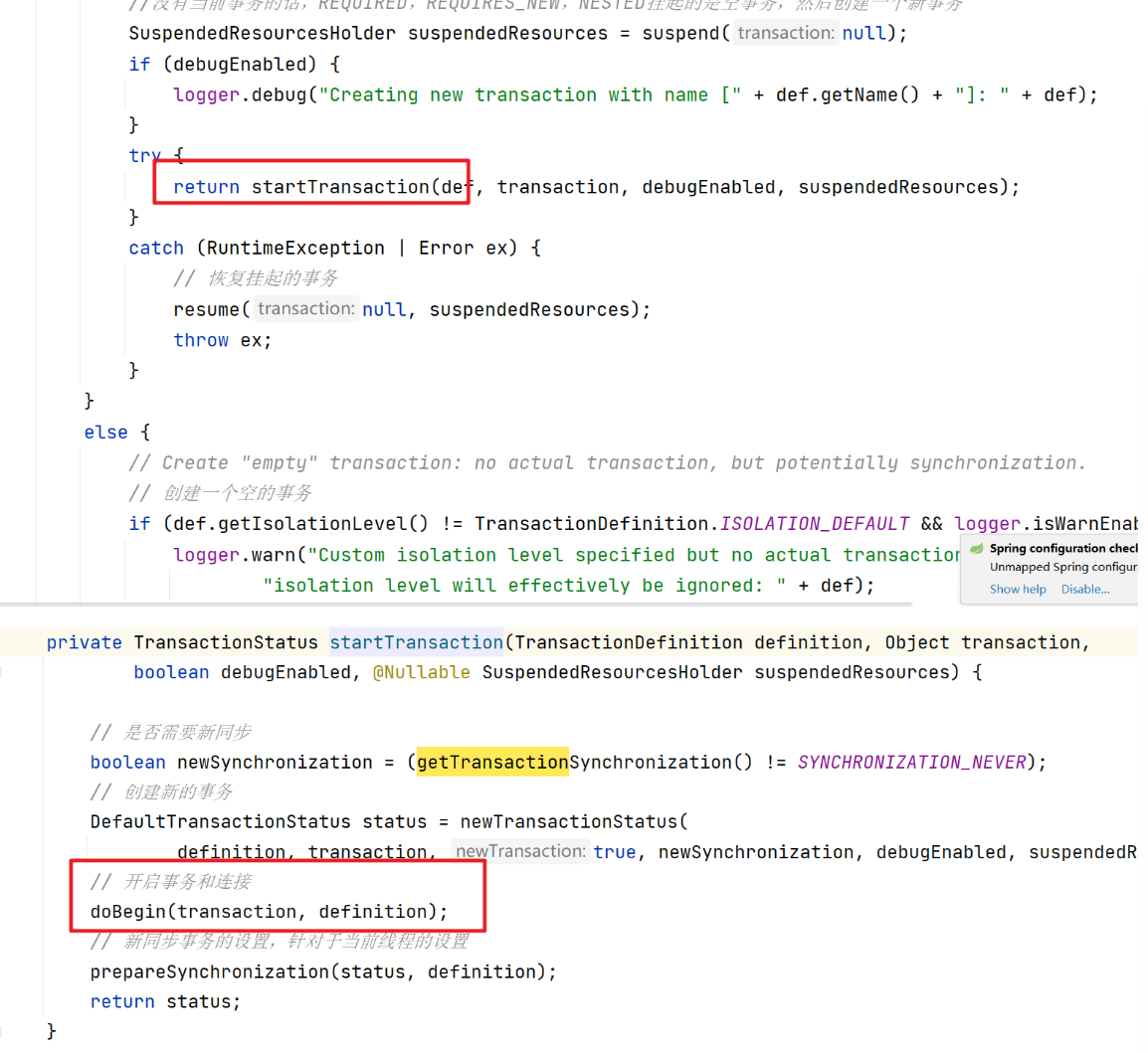
核心的是doBegin方法。完成 自动提交的关闭和 本地线程 对象的存储
TransactionInterceptor
TransactionInterceptor是如何注入到容器中的?
首先来看看事务的开启@EnableTransactionManagement
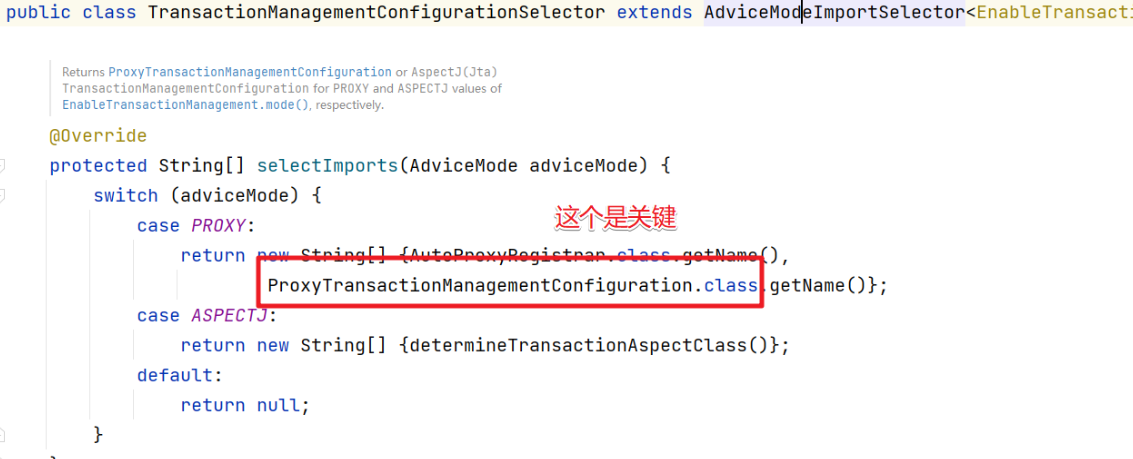

可以看到拦截器关联到了Advisor中
